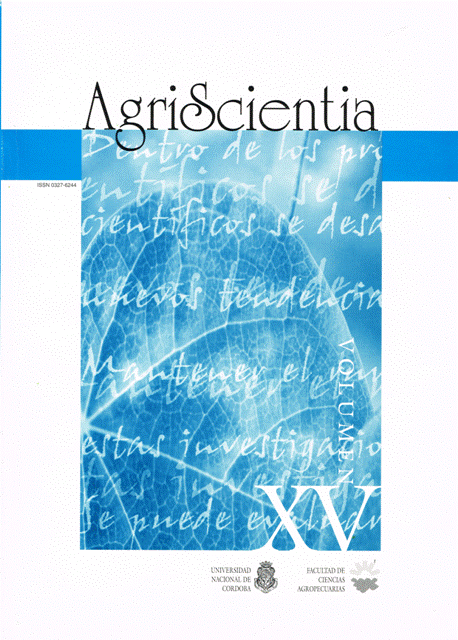Polimorfismo de longitud de fragmentos de restricción asociado a los rasgos de los gránulos de almidón de cebada
Contenido principal del artículo
Resumen
Las características de los gránulos de almidón de la cebada (Hordeum vulgare) fueron mapeadas utilizándose 123 marcadores moleculares RFLP, proporcionando una densidad de cobertura del genoma de aproximadamente 9,6 cM. El programa QTL-STAT fue utilizado para analizar seis características en datos provenientes de 150 di-haploides del cruzamiento de las variedades Steptoe x Morex. Se detectaron 5 regiones cromosómicas (QTLs) (P = 0,001) para área superficial y volúmen de los gránulos A, proporción de gránulos A en relación al almidón total y proporción de número de gránulos B en relación a los gránulos A. Otros posibles QTLs fueron detectados (P = 0,05) para estas cuatro características y para el área superficial y volumen de los gránulos B. La variedad Morex fue la fuente de alelos para aumento del área superficial y volumen de los gránulos A y proporción de los gránulos A en relación al almidón total. La variedad Steptoe contribuyó con alelos para aumento de proporción del número de gránulos B con relación a los gránulos A. Los QTLs para las características de los gránulos A se concentran en tres regiones del cromosoma número 2, y una de estas regiones, la rbcs-abg2
Detalles del artículo
Número
Sección

Esta obra está bajo una licencia internacional Creative Commons Atribución-CompartirIgual 4.0.
Cómo citar
Referencias
Armstrong, E., 1992. Identification, distribution and partial characterization of wheat starch-associated proteins. University of Ottawa. (Ph.D. thesis.). 127p.
Bathgate, G.N. and Palmer, G.H., 1972. A reassessment of the chemical structure of barley and wheat granules. Starch 24:374-379.
Becker, J., Vos, P. and Martin, K., 1995. Combined mapping of AFLP and RFLP markers in barley. Mol. Gen. Genet. 249:65-75.
Chen, F. and P.M. Hayes, 1989. A comparison of Hordeum bulbosum-mediated haploid production efficiency in barley using in vitro floret and tiller culture. Theor. Appl. Genet. 77:701-704.
Gebhardt, C. and Salamini, F., 1992. Restriction fragment length polymorphism analysis of plant genomes and its application to plant breeding. Rev. Cytol. 135:201-237.
Hayes, P.M., B.H. Liu, S.J. Knapp, F. Chen, B. Jones, T. Blake, J. Franckowiak, D.C. Rasmusson, M. Sorrels, S. Ullrich, A. Wesenberg, A. Kleinhofs, and R. Nilan, 1993. Quantitative trait locus effects and environmental interaction in a sample of North American barley germplasm. Theor. Appl. Genet. 87:392-401.
Heun, M., 1992. Mapping quantitative powdery mildew resistance of barley using a restriction fragment length polymorphism map. Genome 35:1019-1025.
Holloway, J.L. and S.J. Knapp, 1994. GMendel 3.0 User Guide, Oregon State University, Department of Crop and Soil Science, Corvallis, OR, USA.
Kleinhofs, A., A. Kilian, M.A. Saghai Maroof, R.M. Biyashev, P.M. Hayes, F. Chen, N. Lapitan, A. Fenwick, T.K. Blake, V. Kanzin, E. Ananiev, M. Heun, D. Kudrna, J. Bollinger, S.J. Knapp, B.H. Liu, M. Sorrels, M. Heun, J. Franckowiak, D. Hoffman, R. Skadsen, and B.J. Steffenson, 1993. A molecular, isozyme, and morphological map of the barley (Hordeum vulgare) genome. Theor. Appl. Genet. 86:705-712.
Knapp, S.J. and W.C. Bridges, 1990. Using molecular markers to estimate quantitative trait locus parameters, power and genetic variances for unreplicated and replicated progeny. Genetics 126:769-777.
Laurie, D.A., Pratchett, N., Devos, K.M., Leitch, I.J., and Gale, M.D., 1993. The distribution of RFLP markers on chromosome 2 (2H) of barley in relation to the physical and genetic location of 5S rDNA. Theor. Appl. Genet. 87:177-183.
Macgregor, A.W. and D.L. Ballance, 1980. Hydrolysis of large and small starch granules from normal and waxy barley cultivars by α-amylases from barley malt. Cereal Chem. 57:397-402.
Mansur, L., K.G. Lark, H. Kross, and A.B. Oliveira, 1993. Interval mapping of quantitative trait loci for reproductive, morphological and seed traits of soybean (Glycine max L.). Theor. Appl. Genet. 86:907-913.
Mather, D.E., Tinker, N.A., Laberge, D.E., Edney, M., Jones, B.L., Rossnagel, B.G., Legge, W.G., Briggs, K.G., Irvine, R.B., Falk, D.E., and Kasha, K.J., 1997. Regions of the genome that affect grain and malt quality in a North American two-row barley cross. Crop Sci. 37:544-554.
Oliveira, A.B., D.C. Rasmusson and R.G. Fulcher, 1994. Genetic aspects of starch granule traits in barley. Crop Sci. 34:1176-1180.
Parentoni, S.N., 1993. Mapping quantitative loci for maturity and correlated traits in maize using RFLP markers. M.S. Thesis. University of Minnesota, St. Paul, MN.
Paterson, A., S.D. Tanksley, and M.E. Sorrels, 1991. DNA markers in plant improvement. Advances in Agronomy 46:39-90.
Pierce, J.S., 1991. European Brewery Convention - advances in malting barley. Barley and Malt Committee of the European Brewery Convention. 32 p.
Quarrie, S.A., Laurie, D.A., Zhu, J.H., Lebreton, C., Semikhodskii, A., Steed, A., Witsenboer, H., and Castlestani, C., 1997. QTL analysis to study the association between leaf size and abscisic acid accumulation in droughted rice leaves and comparisons across cereals. Plant Mol. Biol. 35:155-165.
Tinker, N.A., and Mather, D.E., 1995. MQTL: software for simplified composite interval mapping of QTL in multiple environments. Journal of Quantitative Trait Loci 1:2, (http://probe.nalusda.gov:8000/otherdocs/jgtl/1995-02/jgtl6r2.htm).





